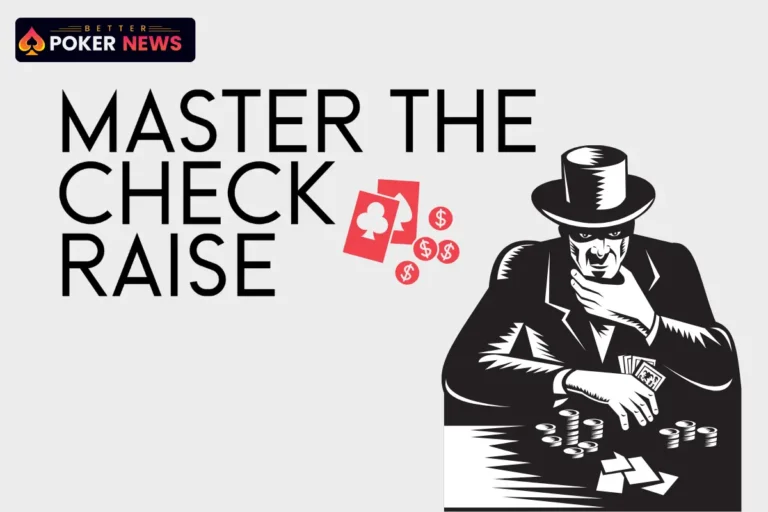Poker Strategy: Check-raising is one of the most effective poker strategies that can significantly impact the outcome of your game. Known for its ability to apply pressure on opponents, the check-raise is an essential tool that every poker player, whether a beginner or seasoned pro, should master. While check-raising can be incredibly effective, it requires strategy, precision, and a deep understanding of your opponent’s behavior to avoid costly mistakes. In this article, we’ll break down the top three tips that will help you perfect your check-raise technique and use it to your advantage.
1. Always Consider the Value of a Bet in Your Poker Strategy
One of the core principles of check-raising in poker strategy is understanding the value of your bet. When you choose to check-raise, it should be because you have a significant advantage over your opponent’s hand. A strong hand should be played aggressively by adding more chips to the pot.
However, it’s crucial to avoid check-raising for the sake of it. Many players make the mistake of check-raising “just because,” which can quickly backfire, especially against skilled opponents. The strength of your hand and the community cards should dictate whether a check-raise is appropriate. For example, if the board is favorable for your range and your opponent seems to have a weaker hand, check-raising can help you build the pot and pressure them into making difficult decisions.
When playing online poker, this principle becomes even more important, as the game tends to be faster-paced and more aggressive. Skilled online players will quickly notice when you are check-raising without a valid reason. Always assess if your hand has enough value and if the board supports a check-raise. A well-timed check-raise in a strong hand can force opponents to fold, making it an effective poker strategy for taking control of the game.
2. Make Use of Data to Enhance Your Poker Strategy
In the online poker world, players have the advantage of using various statistics and tools to gain insight into their opponents’ behaviors. Most poker apps offer features that track and analyze players’ tendencies, giving you a valuable edge when considering a check-raise.
Before committing to a check-raise, take the time to observe your opponent’s tendencies. Are they aggressive in their betting? Do they fold frequently to check-raises or do they tend to call or raise? These patterns can help you adjust your poker strategy accordingly.
For example, if you’re up against a player who rarely folds to a check-raise and has a low continuation bet (c-bet) percentage, it’s better to focus on the value of your hand, as they likely only bet with a strong range. On the other hand, if your opponent has a higher c-bet percentage, they may be more likely to fold to a well-timed check-raise bluff.
By analyzing your opponent’s behavior and adjusting your check-raise strategy based on that data, you can significantly increase the chances of your move succeeding. Always adjust to your opponent’s style, whether they are conservative or aggressive, to maximize your poker strategy.
3. Never Check-Raise on a Pure Bluff
While check-raising can be a powerful poker move, one of the most important things to remember is never check-raise on a pure bluff. The general rule of thumb is to use the check-raise as a value bet or a semi-bluff. Bluffing without any potential equity, such as when holding a weak hand, can be risky and lead to significant losses.
However, check-raising with a semi-bluff can be an extremely effective strategy. A semi-bluff involves holding a hand that may improve on the next street (such as a drawing hand). Even if your opponent calls your check-raise, you still have the opportunity to improve your hand with the next community card. Additionally, you can continue to apply pressure by making additional bets if the board develops favorably.
For instance, if you hold a flush draw or a straight draw, you can check-raise to force your opponent to fold, but even if they call, you still have the chance to improve your hand. This reduces the risk of check-raising purely as a bluff, and you retain control over the hand, potentially winning even if your opponent doesn’t fold initially.
Conclusion: Implementing the Check-Raise in Your Poker Strategy
Mastering the check-raise in poker strategy requires understanding the value of your bets, utilizing available data, and knowing when to use it as a semi-bluff rather than a pure bluff. By following these tips, you can make the most of this potent poker move. Every hand is unique, so stay adaptable and adjust your strategy based on the specific dynamics of the table. With practice and careful observation, you’ll enhance your poker strategy and increase your chances of consistently winning at the table.


1 Comment
Pingback: Poker Dream Jeju Main Event: Li Dong Wins